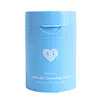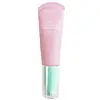What's inside
What's inside
 Key Ingredients
Key Ingredients

 Benefits
Benefits

 Concerns
Concerns

 Ingredients Side-by-side
Ingredients Side-by-side

Water
Skin ConditioningButylene Glycol
HumectantIsohexadecane
EmollientPolyacrylamide
Avena Sativa Kernel Extract
AbrasiveOryza Sativa Bran Extract
Skin ConditioningInositol
HumectantGlycyrrhiza Glabra Root Extract
BleachingGlycerin
HumectantPolysorbate 20
EmulsifyingC13-14 Isoparaffin
EmollientC9-11 Pareth-6
EmulsifyingAluminum Starch Octenylsuccinate
AbsorbentAscorbyl Glucoside
AntioxidantParfum
MaskingDMDM Hydantoin
PreservativeSodium Hyaluronate
HumectantCollagen
MoisturisingSodium Lactate
BufferingWater, Butylene Glycol, Isohexadecane, Polyacrylamide, Avena Sativa Kernel Extract, Oryza Sativa Bran Extract, Inositol, Glycyrrhiza Glabra Root Extract, Glycerin, Polysorbate 20, C13-14 Isoparaffin, C9-11 Pareth-6, Aluminum Starch Octenylsuccinate, Ascorbyl Glucoside, Parfum, DMDM Hydantoin, Sodium Hyaluronate, Collagen, Sodium Lactate
Water
Skin ConditioningEthylhexyl Methoxycinnamate
UV AbsorberPropanediol
SolventButylene Glycol
HumectantCaprylic/Capric Triglyceride
MaskingGlycerin
HumectantLactobionic Acid
BufferingPalmitoyl Pentapeptide-4
Skin ConditioningPolyacrylamide
C13-14 Isoparaffin
EmollientLaureth-7
EmulsifyingBeta-Glucan
Skin ConditioningSodium Hyaluronate
HumectantSaccharide Isomerate
HumectantTetrapeptide-44
Skin ConditioningAcetyl Hexapeptide-8
HumectantBisabolol
MaskingTocopheryl Acetate
AntioxidantArtemisia Capillaris Extract
Pentylene Glycol
Skin ConditioningHelianthus Annuus Seed Oil
EmollientSpirulina Platensis Extract
Skin ProtectingMalus Domestica Fruit Extract
AntioxidantMaltodextrin
AbsorbentCaprylyl Glycol
Emollient1,2-Hexanediol
Skin ConditioningEthylhexylglycerin
Skin ConditioningCitric Acid
BufferingSodium Citrate
BufferingPhenoxyethanol
PreservativeSucrose
HumectantTromethamine
BufferingWater, Ethylhexyl Methoxycinnamate, Propanediol, Butylene Glycol, Caprylic/Capric Triglyceride, Glycerin, Lactobionic Acid, Palmitoyl Pentapeptide-4, Polyacrylamide, C13-14 Isoparaffin, Laureth-7, Beta-Glucan, Sodium Hyaluronate, Saccharide Isomerate, Tetrapeptide-44, Acetyl Hexapeptide-8, Bisabolol, Tocopheryl Acetate, Artemisia Capillaris Extract, Pentylene Glycol, Helianthus Annuus Seed Oil, Spirulina Platensis Extract, Malus Domestica Fruit Extract, Maltodextrin, Caprylyl Glycol, 1,2-Hexanediol, Ethylhexylglycerin, Citric Acid, Sodium Citrate, Phenoxyethanol, Sucrose, Tromethamine
Ingredients Explained
These ingredients are found in both products.
Ingredients higher up in an ingredient list are typically present in a larger amount.
Butylene Glycol (or BG) is used within cosmetic products for a few different reasons:
Overall, Butylene Glycol is a safe and well-rounded ingredient that works well with other ingredients.
Though this ingredient works well with most skin types, some people with sensitive skin may experience a reaction such as allergic rashes, closed comedones, or itchiness.
Learn more about Butylene GlycolThis ingredient is also known as "C13-14 Isoalkane".
C13-14 Isoparaffin is created from petroleum-based mineral oils. It is an emollient and helps thicken a product.
As an emollient, it helps keep the skin soft and smooth by creating a barrier on top. This barrier traps moisture in, keeping the skin hydrated.
C13-14 Isoparaffin may not be fungal-acne safe.
Learn more about C13-14 IsoparaffinGlycerin is already naturally found in your skin. It helps moisturize and protect your skin.
A study from 2016 found glycerin to be more effective as a humectant than AHAs and hyaluronic acid.
As a humectant, it helps the skin stay hydrated by pulling moisture to your skin. The low molecular weight of glycerin allows it to pull moisture into the deeper layers of your skin.
Hydrated skin improves your skin barrier; Your skin barrier helps protect against irritants and bacteria.
Glycerin has also been found to have antimicrobial and antiviral properties. Due to these properties, glycerin is often used in wound and burn treatments.
In cosmetics, glycerin is usually derived from plants such as soybean or palm. However, it can also be sourced from animals, such as tallow or animal fat.
This ingredient is organic, colorless, odorless, and non-toxic.
Glycerin is the name for this ingredient in American English. British English uses Glycerol/Glycerine.
Learn more about GlycerinPolyacrylamide is a synthetic polymer. It is used to stabilize products and bind ingredients. When hydrated, Polyacrylamide forms a soft gel.
Polyacrylamide is low-toxicity. If source properly, it is deemed safe to use in cosmetics.
It should be noted the precursor to Polyacrylamide is acrylamide. Acrylamide is a carcinogen. Most reputable sources of Polyacrylamide will screen for residual acrylamide to make sure the count is in a safe range. Acrylamide is not able to be absorbed through the skin.
We recommend speaking with a professional if you have concerns.
Learn more about PolyacrylamideSodium Hyaluronate is hyaluronic acid's salt form. It is commonly derived from the sodium salt of hyaluronic acid.
Like hyaluronic acid, it is great at holding water and acts as a humectant. This makes it a great skin hydrating ingredient.
Sodium Hyaluronate is naturally occurring in our bodies and is mostly found in eye fluid and joints.
These are some other common types of Hyaluronic Acid:
Learn more about Sodium HyaluronateWater. It's the most common cosmetic ingredient of all. You'll usually see it at the top of ingredient lists, meaning that it makes up the largest part of the product.
So why is it so popular? Water most often acts as a solvent - this means that it helps dissolve other ingredients into the formulation.
You'll also recognize water as that liquid we all need to stay alive. If you see this, drink a glass of water. Stay hydrated!
Learn more about Water